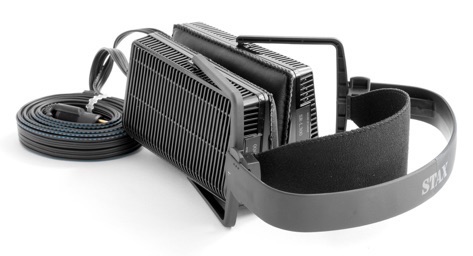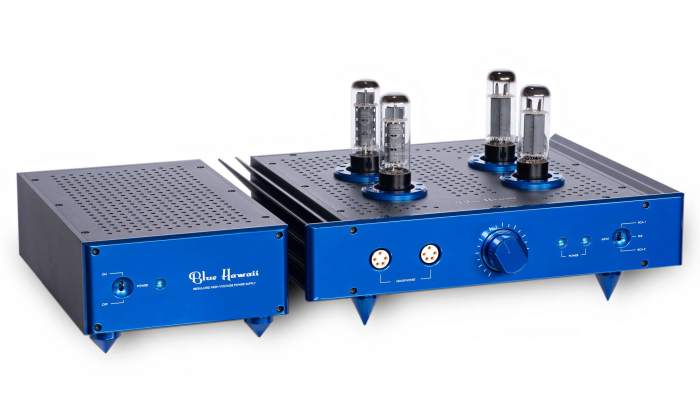Audiophilia: Electrostatic Headphones
There are three main technologies for headphone drivers. I want to talk about the most expensive and idiosyncratic of these, the electrostatic driver. There’s one more that’s even more bonkers but I’ll get to that one in another article. Anyway, to understand why it’s so interesting, I want to briefly describe the other two technologies to contrast with electrostatics.
The cheapest and most common technology is the dynamic driver, which are just very tiny, very sensitive speakers. They have an electromagnet which changes its strength and polarity according to the input voltage. This electromagnet is attached to a diaphragm that moves to create sound. There’s another permanent ring magnet that sits just outside the electromagnet, and it’s the interactions between these two magnetic fields that causes the diaphragm to move.
The next technology up from dynamic drivers, in terms of cost and sophistication, are planar magnetic drivers. To make one, you need a very thin membrane with tiny wires embedded in it. You connect these wires to the input power and electricity will flow according to the voltage. Next, you suspend this membrane-with-wires in the magnetic field generated by two sets of permanent magnets on either side that have very precisely calibrated strengths. Finally, you flow current through the wire, and when current flows through a conductor it produces a magnetic field. This magnetic field interacts with the magnets on either side, and because the membrane is so thin and light, the interaction between the magnetic fields is enough to vibrate the membrane.
Planar magnetic technology is more expensive because of the precision required in the materials for even a basic implementation. The lower threshold for sophistication in dynamic drivers is much lower, since it’s just a careful coil of wire and a ring magnet. The upshot of planar magnetic technology is that even a basic implementation will yield excellent detail due to the lightweight membrane. Dynamic drivers can use exotic materials to achieve the same detail because the combination of voice coil and diaphragm is relatively heavy. Exotic materials are expensive, of course.
Electrostatic headphones are similar to planar magnetic, but with everything dialed up to 11.
The Price
The cheapest electrostatic headphone on the market that I’m aware of is made by Koss and available on Drop (neé Massdrop). It is $500. It is widely reviewed to be Fine, which for $500 is unacceptable, at least in my opinion. Also, to get the price down that low, they apparently had to cut corners on the build quality, so it’s a plasticy cheap feeling thing.
If you are familiar with the world of electrostatic headphones already, you may be itching to point out that the Stax SR-L300 retails for $430, and you’d be correct. But you’ll also know that, unlike the Koss, that $430 does not include the price of the special electrostatic amplifier.
Stax SR-L300

Can we take a second and just admire how ridiculous these look? They sell them brand new in 2019. [Retrieved from staxaudio.com ]
I wanted to talk about price first, because it leads into the point of why you need a special electrostatic amplifier. The point is that you do need one, and that’s why they are so expensive.
Stax are the most recognizable name in electrostatic headphones. They’ve been doing it since the 1960’s and have a huge following. Their most expensive headphone without the amplifier is the SR-009S which costs $4,325. That’s very expensive, but there are dynamic and planar magnetic headphones in the same price bracket. Now consider the amplifiers they sell. Confusingly, they refer to them as “Drivers”. I will not, because that’s confusing in an article where I’m talking about headphone technology. They used to call them “Energizers” which is a much sillier and better name.
Their cheapest (non-portable) amplifier is $975, but reviews I’ve read seem to agree that it’s not powerful enough. Take that with a huge helping of salt. If that’s true, that makes the minimum investment in a Stax system $1,405, and you’ll likely need to spend even more than that to get the True Power. Their most expensive amplifier is the SRM-T8000 which costs $5,800.
Driving electrostatic headphones
What does this amplifier/driver/energizer actually do? To understand that, we can finally get back to the technology. Similar to planar magnetic drivers, electrostatics have a thin membrane sandwiched between two things. Unlike planar magnetics, this membrane has no wires embedded in it. It’s just a very thin sheet of plastic. This makes it much lighter than the already very light membrane of the planar magnetic.
To get this sheet of plastic to move, it uses static charges, like rubbing a balloon on the wall to make it stick. The special amplifier contains a step-up transformer that can provide high voltages to the two surfaces surrounding the membrane. The high charge causes the low mass membrane to move without any electrical conductors or magnets embedded in it.

Go read wikipedia for a better exaplanation than I could ever give [Retrieved from en.wikipedia.org ]
The consequences of this are even better detail than planar magnetic, but less bass because the membrane is so light and it’s not allowed to move very far. People love this.
I think people also love how exclusive they are. The special needs of these headphones and the fact that you can get something basically just as good (or better, for certain types of music) for a much lower total cost means that only serious audiophiles go for them. This also means that there’s very little objective information out there about the special amplifiers or the headphones themselves. There are third party manufacturers that make well-regarded electrostatic amplifiers, and all of them that I can think of use vacuum tubes. Even Stax uses vacuum tubes in their mid- and high-end amplifiers. This is because vacuum tubes operate at very high voltages naturally, so they’re a good match for the needs of electrostats.
Of course, vacuum tubes are their own topic. Suffice it to say that they are not transparent, and the good ones are very expensive because they’re all old ones from WW2 or a little later. They also tend to defy objectivity because they each sound different. Amplifier manufacturers carefully (they say) select tubes for the sound they want.
It’s very possible to make non-vacuum tube amplifiers. But many audiophiles decry solid state amplifiers as “dry”, “analytical”, “flat” or similar. This is somewhat true in general, but I seem to see it more from discussions of electrostatic amplifiers.
Two reputable boutique electrostatic amplifier manufacturers are Mjolnir Audio ($1,100 for the low voltage model to $6,500 for the top of the line model with fancy volume knob) and HeadAmp with its Blue Hawaii Special Edition starting at $6,000.

Tuuuuubes [Retrieved from headamp.com ]
Price no object
Some of the most expensive headphones ever made have been electrostatics. Forget Stax, pandering to plebians for paltry sums. Let’s talk Sennheiser. They’ve got a special headphone that costs $59,000 called the HE-1. It includes the amplifier, thank goodness. Said amplifier is a marble plinth that also has a little compartment that holds the headphones themselves. There are 8 tubes sticking out of the top.
Another very expensive electrostatic is the Hifiman Shangri-La which is also around $50,000 with amplifier, or $18,000 for just the headphones. The amplifier also has 8 tubes, but 4 of them are bigger than the HE-1’s. Hifiman says they are newly manufactured. Hifiman has other electrostats, like the Shangri-La Jr. for $8,000 with amp, or the Jade II for $1,400.
Electrostatic’s enemy: Dust
One final note about electrostatics. Because the membranes are so thin and light, even tiny motes of dust can affect the sound. Some headphones have protection membranes, but others do not. In general it’s better to keep them stored with a dust cover or in a box. How do you protect them when you’re wearing them?
Looking back
When I was just getting started in audiophilia in high school, Stax was the only real game in town for electrostatics and a hopelessly unattainable goal for a child such as myself. They were also completely ridiculous to behold. Their website was delightfully Japanese, and though I never tried, I’m sure the ordering process was long and special all on its own. They referred to the headphones as Earspeakers and the amplifiers as Energizers. They looked (and still look) completely stupid and unique. The consensus was that they were horribly uncomfortable and cheap feeling, but with unsurpassed sound quality. Owning a pair made you into audiophile royalty, at least in the realm of headphones.
As an older and more experienced person, I see them for what they are – a pursuit of the last tiny iota of sound quality. The ideal speaker has no moving parts except the air itself. Stax, and electrostatics, get just a little closer to that ideal than any other technology. It’s an admirable engineering goal, in my opinion. But as a product for a normal human listening to music, it seems like too much trouble. And that’s audiophilia.
